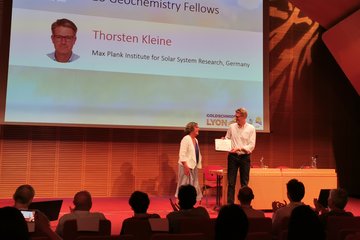Alle Typen
41.
Zeitschriftenartikel
Microscopy capabilities of the Microscopy, Electrochemistry, and Conductivity Analyzer. Journal Geophysical Research 113, E00A22 (2008)
42.
Zeitschriftenartikel
Dust haze in Valles Marineris observed by HRSC and OMEGA on board Mars Express. Journal Geophysical Research 113, E02004 (2008)
43.
Zeitschriftenartikel
Phoenix Robotic Arm Camera. Journal Geophysical Research 113, E00A17 (2008)
44.
Zeitschriftenartikel
Small-scale trench in the north polar region of Mars: Evolution of surface frost and ground ice concentration. Icarus 199, S. 75 - 85 (2008)
45.
Zeitschriftenartikel
Introduction to special section on the Phoenix Mission: Landing Site Characterization Experiments, Mission Overviews, and Expected Science. Journal Geophysical Research 113, E00A18 (2008)
46.
Zeitschriftenartikel
Atmospheric structure and dynamics as the cause of ultraviolet markings in the clouds of Venus. Nature 456 (7222), S. 620 - 623 (2008)
47.
Zeitschriftenartikel
Venus monitoring camera for Venus express. Planetary and Space Science 55 (12), S. 1701 - 1711 (2007)
48.
Zeitschriftenartikel
Morphology and dynamics of the upper cloud layer of Venus. Nature 450 (7170), S. 633 - 636 (2007)
49.
Zeitschriftenartikel
Venus express - The first European mission to Venus. Planetary and Space Science 55 (12), S. 1636 - 1652 (2007)
50.
Zeitschriftenartikel
To the depths of Venus: Exploring the deep atmosphere and surface of our sister world with Venus Express. Planetary and Space Science 54, S. 1263 - 1278 (2006)
51.
Zeitschriftenartikel
Possible remnants of a frozen mud lake in southern Elysium, Mars. Icarus 181, S. 363 - 374 (2006)
52.
Zeitschriftenartikel
Venus Express science planning. Planetary and Space Science 54, S. 1279 - 1297 (2006)
53.
Zeitschriftenartikel
Venus Express: Scientific goals, instrumentation, and scenario of the mission. Cosmic Research 44 (4), S. 334 - 348 (2006)
54.
Zeitschriftenartikel
Evidence from the Mars Express High Resolution Stereo Camera for a frozen sea close to Mars' equator. Nature 434, S. 352 - 356 (2005)
55.
Zeitschriftenartikel
Seasonal melting of surface water ice condensing in martian gullies. Icarus 171 (2), S. 272 - 283 (2004)
56.
Zeitschriftenartikel
The microscope for Beagle 2. Planetary and Space Science 52 (9), S. 853 - 866 (2004)
57.
Zeitschriftenartikel
Inverse radiation modeling of Titan's atmoshere to assimilate Solar Aureole Imager data of the Huygens probe. Planetary and Space Science 51, S. 147 - 158 (2003)
58.
Zeitschriftenartikel
Surface temperature of Martian regolith with polygonal features: influence of the subsurface water ice. Planetary and Space Science 51, S. 569 - 580 (2003)
59.
Zeitschriftenartikel
A spherical model for computing polarized radiation in Titan's atmosphere. Planetary and Space Science 51, S. 977 - 989 (2003)
60.
Zeitschriftenartikel
Martian seasonal CO2 ice in polygonal troughs in southern polar region: role of the distribution of subsurface H2O Ice. Icarus 160, S. 73 - 85 (2002)











